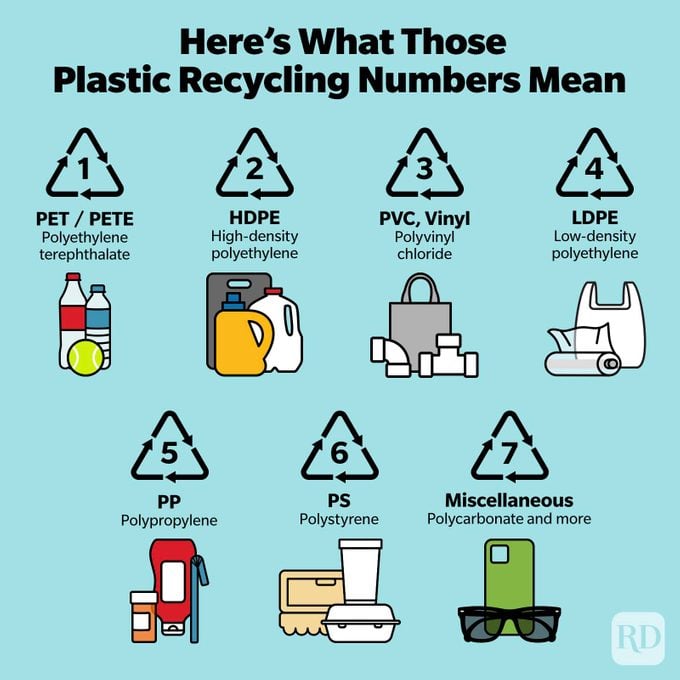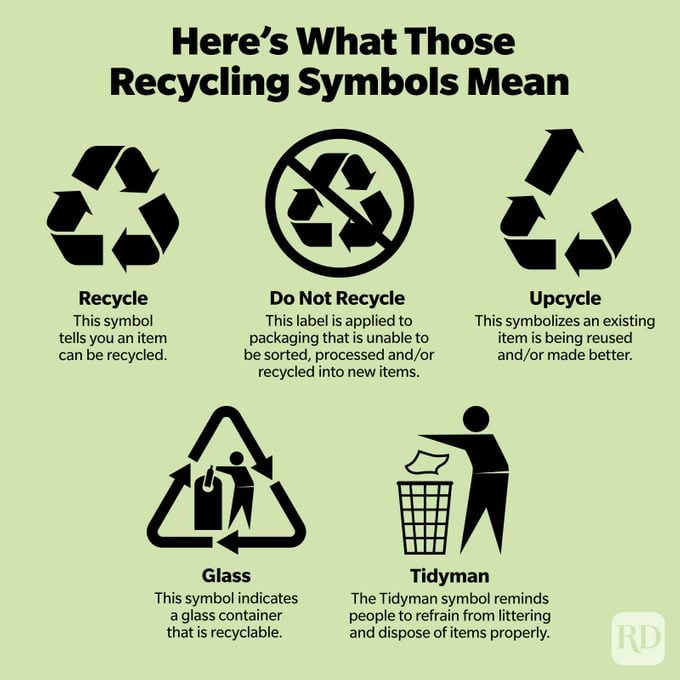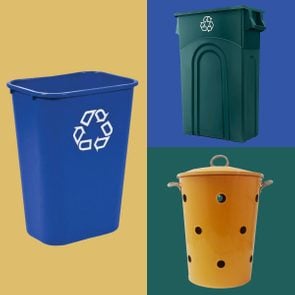What Those Plastic Recycling Numbers and Symbols Really Mean
Updated: Apr. 17, 2024

Recycling can be confusing enough as it is. To help, here's what those little numbers in recycling symbols actually mean.
America is recycling—however, not enough, and not always properly. While we can hope that the future of recycling improves, the reality is that the amount of plastic that actually gets recycled right now is just 8.7% of what’s made, according to the Environmental Protection Agency (EPA). That means that even though you may feel like you’re doing your part to save the planet when you toss that empty water bottle in the recycling bin, that plastic doesn’t always get to the right place. Unfortunately, part of the problem is a general lack of understanding of each recycling symbol and what it means.
Recycling symbols
You may have noticed that all plastic has a symbol with three arrows. This actually has a name, though it’s not well known: It’s called the Mobius Loop, and inside of it is a number—a recycling symbol—that provides details about recycling that material. “The arrows represent circularity and reuse,” shares Mike Scherzer, senior director, product development at iDESIGN, a housewares design company. Inside the Mobius Loop, you’ll find a number one through seven. “The recycling companies use these numbers to sort items into their common material type prior to the next stage of recycling,” Scherzer says.
What do the 7 recycling symbols mean?
If you have no idea what those recycling numbers mean, that’s okay. Read on to learn how to decode each recycling symbol so you can better understand what items should land in your recycling bin.

Resin identification codes
Each recyclable plastic is coded with a number, from one to seven, and according to the American Chemistry Council, each ID is based on the type of plastic resin that’s used. Officially, these are called resin identification codes.
Although the code is often mistaken as a universal sign of recyclability, collectors don’t accept every plastic type, or number. Follow your local rules, and only put the accepted types of plastic in your recycling bin; this helps streamline the recycling process down the line, ultimately making it more successful.
Recycling #1: Polyethylene terephthalate (PET or PETE)
Found in: Single-use plastic water, soda and juice bottles, peanut butter jars, salad dressing bottles, cooking oil bottles, mouthwash, shampoo and liquid hand soap bottles and containers, window cleaner bottles and tennis balls.
Polyethylene terephthalate is commonly abbreviated as either PET or PETE. PET is a popular choice for most drink and food packaging because of its transparency, strength and temperature stability (as in, you can fill it with something hot). Though you’ll mostly find it in the form of jars and other bottles, special-grade PET is sometimes also used for to-go food containers and prepared-food trays that can be heated in the oven or microwave.
“PET is the most recycled material in the world,” Scherzer says. According to the PET Resin Association (PETRA), this particular plastic is accepted at nearly every recycling center across North America. This resin’s unique properties make it great for continual recycling. Annually, America recycles approximately 1.5 billion pounds of PET bottles and containers, though that number could be a lot higher; PETRA estimates that our rate of PET recycling is only 31%.
Recycling #2: High-density polyethylene (HDPE)
Found in: Milk jugs, laundry detergent and bleach containers, shampoo bottles, cutting boards, piping, shopping bags, wood-plastic composites, snowboards, shoe lasts, 3D printing filament and other plastic bottles.
High-density polyethylene (HDPE) is considered to be tough yet lightweight and is resistant to most solvents. It is almost as common as PET.
Like PET, this resin’s properties make it good for recycling, and it is accepted at most recycling centers. According to Scherzer, recycled HPDE is most often used in plastic lumber, decking and benches.
Recycling #3: Polyvinyl chloride (PVC, Vinyl)
Found in: Pipes, pipe fittings, medical devices, wire and cable insulation, totes and handbags and more.
Polyvinyl chloride (PVC), with the recycle symbol 3, is the world’s third-most widely produced synthetic plastic polymer. Extremely durable and resistant to grease, oil and other chemicals, PVC is ideal for pipes, pipe fittings and different types of insulation because it can be made thin and flexible or rigid (like in industrial pipes). It’s also used for soft, flexible plastic parts like those found in automobile interiors and seat coverings, as well as the insulation on some electrical wires, Scherzer explains.
Generally, PVC is recyclable, though it can be tough to find a recycling center that accepts it, in part because it contains chemicals that could potentially contaminate batches of other types of plastic during the recycling process. Check your local waste guidelines to learn how you should handle PVC.
Recycling #4: Low-density polyethylene (LDPE)
Found in: Grocery bags, garbage bags, juice containers, container lids, squeezable bottles, some toys and cling wrap.
“Low-density polyethylene is a very soft, flexible material, often used to make plastic grocery bags and other bags used for food storage,” Scherzer says. “It can cause some challenges when mixed in the recycling stream with other rigid plastics, so it’s important to recycle it correctly.”
Like HDPE, #4 plastics are accepted at most recycling centers, but the acceptance of LDPE is a more recent development, so be sure to check your local guidelines to see if it can be picked up curbside. As always, make sure you rinse items—especially food containers—well before recycling.
Recycled LDPE can be used to make floor tile, furniture, compost and trash bins, shipping envelopes and more.
Recycling #5: Polypropylene (PP)
Found in: Yogurt containers, ketchup bottles, syrup bottles, straws, laundry detergent bottle caps, carpeting fibers, medicine bottles and some water bottles.
Extremely durable and resistant to stress, even when flexed, PP is one of the safer plastics and has a high melting point, which makes it technically microwavable. (Although The Healthy warns against microwaving PP—or any plastic, for that matter—due to the potential toxins plastic leaches when heated.)
In terms of the overall recyclability of polypropylene, the U.S. is well equipped to handle #5 plastics, and PP is recyclable. It can be recycled into brooms, bins, pallets, signal lights, ice scrapers, auto battery cases and bicycle racks.
Recycling #6: Polystyrene (PS)
Found in: Disposable coffee cups, packing peanuts, coolers, to-go food containers, foam trays, CD cases, egg cartons and other Styrofoam products.
Polystyrene (PS) is a versatile plastic that can be made into hard, solid plastic or “foamed” to make Styrofoam then used as insulation for coolers, disposable hot drink cups or packaging to help protect items during shipping, Scherzer explains.
PS is problematic for a number of reasons. When it’s made, it leaches potentially harmful toxins, particularly when heated; it’s listed as a likely carcinogen by the U.S. Department of Health and Human Services, and exposure can cause irritation to the skin, eyes, gastrointestinal tract and respiratory tract, as well as cause a host of other problems.
Practically speaking, non-foamed PS is brittle and can crack or break easily, Scherzer explains. “If you’re old enough to have a collection of music CDs that came in clear plastic hinged cases, and you accidentally dropped one and it shattered into multiple pieces, you know the limitations of PS.”
Then, by some estimates, Styrofoam takes up to 500 years to decompose, and because of its bulk, it’s estimated to take up to 30% of the space in many landfills.
Though Styrofoam is technically recyclable, it’s not usually accepted at recycling centers. Because it’s so light, PS breaks apart quite easily, which can cause contamination of other materials. In addition, it’s also extremely tricky to clean because of its porous nature. Last, it doesn’t get recycled often because it’s simply not as cost-effective to recycle PS, which is why many centers don’t do so in the first place.
Check your local guidelines for their recommendations on recycling PS. If you’re working with packing peanuts and packing wrap, find out if bubble wrap is recyclable.
Recycling #7: Miscellaneous
Found in: Citrus juice bottles, sunglasses, phone cases and other items with mixed, custom packaging.
Recycling symbol #7 is a catch-all for all other types of plastic. You may see this on some citrus juice bottles, custom packaging or mixed packaging featuring different plastics. Because of its broad nature, plastics numbered 7 are often not accepted by recycling centers, and generally, they don’t get recycled.
Common recycling symbols
In addition to Resin Identification Codes, there are also some common recycling symbols that are important to know.

Recycle
The Mobius Loop symbol tells you an item can be recycled.
Do Not Recycle
The symbol for “do not recycle,” this label is applied to packaging that is unable to be sorted, processed and/or recycled into new items.
Upcycle
This symbolizes that an existing item is being reused and/or made better.
Glass
This symbol indicates a glass container that is recyclable. Glass may be picked up by some curbside recycling programs, but it depends on your local recycling regulations. If it’s not part of your program, you can look for a local drop-off location.
Tidyman
As a symbol, the Tidyman reminds people to refrain from littering and dispose of items correctly.
How to recycle properly
Recycling is a process that can save money and energy, and reduce waste. However, it’s crucial to do it right. “Most all plastics with recycling numbers can be recycled, but often they are not, due to difficulty in sorting the used items into their common material type,” Scherzer adds. Remember to always look for the recycling symbol and resin identification code on your used plastic, and when in doubt, consult your local recycling guidelines for more information using the Recycling Facility Locator tool.
Now that you know all about recycling symbols, make sure to recycle properly, which includes knowing what to do with bottle caps and old books and taking the extra step to upcycle, including upcycling old clothes (and other items that can be upcycled).
Sources:
- Mike Scherzer, senior director, product development at iDESIGN
- American Chemistry Council: Chemistry of Plastics























